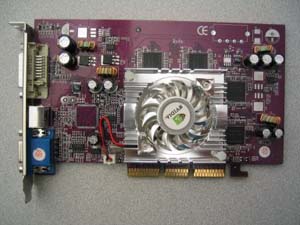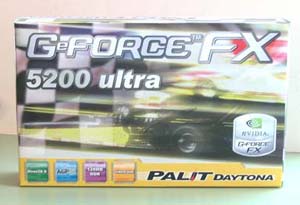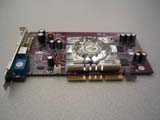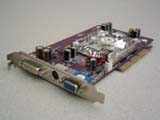It is obvious GeForce FX videocards have begun their rise into the graphics market. PalitDaytona brings us the little brother of the group, the FX 5200 Ultra. If you have been scoping out the next generation of video cards, check out this review to see where the FX 5200 Ultra stands.
Introduction
I have been given the opportunity to take a look at one of the newest arrivals from PalitDaytona’s line of video cards, the GeForce FX 5200 Ultra 128MB. This is one of Palit’s entry-level cards in its line of GeForce FX products, which also includes the FX 5200 128MB, FX 5600 256MB, and the FX 5900 128MB and 256MB versions. As you can see, Palit has quite the arsenal of high performance video enjoyment. Palit Microsystems has been in the business for more than 12 years now, so they are definitely not a newcomer when it comes to graphics.
With options becoming more and more abundant, the consumer can easily be left in the dust when it comes to the latest and greatest in video cards. I hope that this review will help shed a little light on any questions you may have while deciding what will rest in your PC’s AGP slot.
 |
 |
Here is a taste of all the latest and greatest features of the FX 5200 Ultra straight from Palit’s spec sheet.
Features:
- Controller:
nVIDIA GeForce FX 5200 Ultra AGP 256-bit GPU 2D/3D Graphics and Video Accelerator.
325MHz Core clock
1.3 billion Fill Rate (texel/sec.)
81 million Vertices/sec. - Bus Type:
AGP 8x including Fast Writes and sideband addressing - Memory:
128MB DDR
128-bit Interface
10.4GB/sec Bandwidth
650MHz Memory Data Rate - Integrated RAMDAC:
Dual 350MHz Support QXGA display with ergonomic refresh rates up to 2048×1536@75Hz - Monitors Supported:
Standard and Multi-frequency Analog Monitors.
DDC2B Plug and Play. - Connectors:
DB-15 analog monitor connector (VESA DDC2B).
S-Video for TV-Out, DVI -I - TV-Out Supported:
PAL/NTSC TV-Out system with flick filter - Video Playback: TV-Out 1024×768 resolution
Integrated full hardware MPEG-2 decoder
64-phase Video Scaler – Scaling DVD and other video to full screen HDTV resolution - Display:
nVIDIA nView multi-display technology
nVIDIA Digital Vibrance Control (DVC) 3.0 - High-Quality 3D Feature Set:
nVIDIA CineFX engine
– CineFX shading architecture
Support for DX 9 pixel shader 2.0+, vertex shader2.0+
Z-correct bump-mapping
Hardware-accelerated shadow effects with shadow buffers
Two-sided stencil– High-performance, high-precision 3D rendering engine
4-pixels per clock rendering engine
129-bit, studio-quality floating point through the entire pipeline
S3TC texture compression
Native support for 129-bit floating point, 64-bit floating point and 32-bit integer rendering mode– Antialiasing
Blistering-fast antialiasing performance
Adaptive texture filtering
Fast Z-clear– Advanced display pipeline with full nView capability
- Software:
DirectX 9.0 and OpenGL 1.4 Optimization and support
Support Windows XP, 2000, NT(all), 9x and Linux Compatibility
nVIDIA Unified Driver Architecture(UDA)
Full compliant professional OpenGL 1.4 API with nVIDIA extensions, on all Linux and Windows operating systems
WHQL-certified for Windows XP, Windows Me, Windows 2000
Complete Linux Xfree86 drivers
Package Contents:
- GeForce FX5200 Ultra 128MB video card
- S-Video cable
- Power DVD 4.0
- Drivers CD

 |
 |
 |
The card has quite the eye appeal with its great purple color and chrome colored fan. It is an attractive add-on to those with windows on their cases that like to show off a little computer bling-bling. The bundle is nothing to get too excited about unfortunately. The addition of PowerDVD and the S-Video cable make it worthwhile, but overall it’s a light bundle.
Installation
There isn’t much to say when it comes to installation of this card. The card was easy to place in the AGP slot, I booted my PC, and Windows XP found the card right away. I already had nVIDIA drivers loaded on my machine, so the software installed automatically and testing began. I don’t think installation can get any simpler than that!
Testing
I put the FX 5200 Ultra up against my current GeForce4 Ti4200 64MB. They are similar cards aimed at a similar audience. They are also in the same approximate price range at the time of this review, and I know that everyone is looking at that number when deciding to buy.
I put the cards through the benchmarking barrage one at a time. Each card was put through 3dMark 2001 SE, Comanche 4, and Unreal Tournament 2003 to get some diehard stats that the scientific mind can approve of. I then wanted to see what the FX 5200 Ultra could do when I gave the core and memory speeds a little bit of a boost. Finally, I think it will be useful to give a quick test of the actual playability of the cards. I want to give a subjective look on the overall feel of the card and how well it actually performs in a real-life situation. No numbers, no statistics, just a “tell it like it is” (in other words, does it play games well?).
Test System
- AMD Athlon XP 2500+ @ 3200+ (2.2Ghz)
- Asus A7N8X Deluxe nForce2 Motherboard
- Western Digital 80GB HDD 8MB Buffer
- 2x256MB Corsair XMS PC3200 DDR RAM
- 24/12/40 TDK VeloCD CDRW
- Creative Labs Sound Blaster Audigy
- nVIDIA Detonator 44.03 drivers
3dMark 2001 SE Build 330
Setting: No AA, No Anisotropic Filtering
| GFX Card/GPU | |
|
1024×768
|
|
| GeForce FX 5200 Ultra | |
| GeForce4 Ti4200 | |
|
1280×1024
|
|
| GeForce FX 5200 Ultra | |
| GeForce4 Ti4200 | |
|
1600×1200
|
|
| GeForce FX 5200 Ultra | |
| GeForce4 Ti4200 |
Setting: 4x AA, 8x Anisotropic Filtering
| GFX Card/GPU | |
|
1024×768
|
|
| GeForce FX 5200 Ultra | |
| GeForce4 Ti4200 | |
|
1280×1024
|
|
| GeForce FX 5200 Ultra | |
| GeForce4 Ti4200 | |
|
1600×1200
|
|
| GeForce FX 5200 Ultra | |
| GeForce4 Ti4200 |
You can easily see where the strength in the FX5200 Ultra is. The Ti4200 is able to take the FX5200 Ultra hands down in tests without AA or anisotropic filtering, but the FX5200 Ultra begins to turn the tides when the settings are cranked up. The Ti4200 was not able to run 3dMark at 1600×1200 with AA and anisotropic filtering on.
Comanche 4 Demo
Setting: No AA, No Anisotropic Filtering
| GFX Card/GPU | |
|
1024×768
|
|
| GeForce FX 5200 Ultra | |
| GeForce4 Ti4200 | |
|
1280×1024
|
|
| GeForce FX 5200 Ultra | |
| GeForce4 Ti4200 | |
|
1600×1200
|
|
| GeForce FX 5200 Ultra | |
| GeForce4 Ti4200 |
Setting: 4x AA, 8x Anisotropic Filtering
| GFX Card/GPU | |
|
1024×768
|
|
| GeForce FX 5200 Ultra | |
| GeForce4 Ti4200 | |
|
1280×1024
|
|
| GeForce FX 5200 Ultra | |
| GeForce4 Ti4200 | |
|
1600×1200
|
|
| GeForce FX 5200 Ultra | |
| GeForce4 Ti4200 |
The results continue to tell the same story. Without the added AA and filtering, the Ti4200 is first to the finish line. When the pressure is put on by adding the 4x AA and the 8x anisotropic filtering, the FX5200 Ultra flexes its muscle a little and pulls into the lead.
Testing Cont.
For the Unreal Tournament 2003 benchmarks I used the UT2K3 utility created by S.L.A.G.D courtesy of Ben’s Custom Cases. This is a great utility for anyone to see how well their system can stand up to UT2K3. Each card was benched with both the Antalus and Inferno Flyby benchmarks with and without AA and AF.
Unreal Tournament 2003
Setting: Antalus Flyby, No AA, No Anisotropic Filtering
| GFX Card/GPU | |
|
1024×768
|
|
| GeForce FX 5200 Ultra | |
| GeForce4 Ti4200 | |
|
1280×1024
|
|
| GeForce FX 5200 Ultra | |
| GeForce4 Ti4200 | |
|
1600×1200
|
|
| GeForce FX 5200 Ultra | |
| GeForce4 Ti4200 |
Setting: Antalus Flyby, 4x AA, 8x Anisotropic Filtering
| GFX Card/GPU | |
|
1024×768
|
|
| GeForce FX 5200 Ultra | |
| GeForce4 Ti4200 | |
|
1280×1024
|
|
| GeForce FX 5200 Ultra | |
| GeForce4 Ti4200 | |
|
1600×1200
|
|
| GeForce FX 5200 Ultra | |
| GeForce4 Ti4200 |
Setting: Inferno Flyby, No AA, No Anisotropic Filtering
| GFX Card/GPU | |
|
1024×768
|
|
| GeForce FX 5200 Ultra | |
| GeForce4 Ti4200 | |
|
1280×1024
|
|
| GeForce FX 5200 Ultra | |
| GeForce4 Ti4200 | |
|
1600×1200
|
|
| GeForce FX 5200 Ultra | |
| GeForce4 Ti4200 |
Setting: Inferno Flyby, 4x AA, 8x Anisotropic Filtering
| GFX Card/GPU | |
|
1024×768
|
|
| GeForce FX 5200 Ultra | |
| GeForce4 Ti4200 | |
|
1280×1024
|
|
| GeForce FX 5200 Ultra | |
| GeForce4 Ti4200 | |
|
1600×1200
|
|
| GeForce FX 5200 Ultra | |
| GeForce4 Ti4200 |
Results on Unreal Tournament were right on par with the previous numbers. The FX5200 Ultra has the ability to handle the more intensive, image-improving abilities of AA and AF. The Ti4200 can’t keep up in the long run when the stakes are raised. Although we aren’t seeing very many playable frame rates here, it’s still interesting to see how the 5200 beats out the 4200 as the tests get more demanding.
Overclocking
Now that the standard testing is complete, it is time to see what this card can do with a little tweaking. Using the standard nVIDIA driver controls, I set out to find a higher stable core and memory speed for the FX 5200 Ultra. The stock settings for the card are 325MHz core and 650MHz memory. After a little trial and error, I settled at 350MHz core and 675MHz memory speeds. This speed was the highest that I was able to run and complete a full run of 3dMark 2001 SE. The card has run stable for more than a day at this speed, and I have not experienced any video quality issues in 2D or 3D applications.
3dMark 2001 SE Build 330
Setting: No AA, No Anisotropic Filtering
| GFX Card/GPU | |
|
1024×768
|
|
| GeForce FX 5200 Ultra (325/650) | |
| GeForce FX 5200 Ultra (350/675) | |
|
1280×1024
|
|
| GeForce FX 5200 Ultra (325/650) | |
| GeForce FX 5200 Ultra (350/675) | |
|
1600×1200
|
|
| GeForce FX 5200 Ultra (325/650) | |
| GeForce FX 5200 Ultra (350/675) |
Setting: 4x AA, 8x Anisotropic Filtering
| GFX Card/GPU | |
|
1024×768
|
|
| GeForce FX 5200 Ultra (325/650) | |
| GeForce FX 5200 Ultra (350/675) | |
|
1280×1024
|
|
| GeForce FX 5200 Ultra(325/650) | |
| GeForce FX 5200 Ultra (350/675) | |
|
1600×1200
|
|
| GeForce FX 5200 Ultra (325/650) | |
| GeForce FX 5200 Ultra (350/675) |
Results from the overclocking were quite good. With an increase of around 200 marks for each test, the card showed a good increase in performance. Game tests showed no obvious visual improvements, but most scores increased an average of five FPS.
Playability
I took several hours to play through many of the games that I play on a regular basis. I wanted to see just how well this card would perform on an all-around basis. I am happy to say that the PalitDaytona FX 5200 Ultra passed my “playability test” with flying colors.
Unreal Tournament 2003 played very smoothly all the way up to 1280×1024 with all options on high. The increased performance when using 4x AA and 8x AF did a great job improving visual quality over my existing Ti4200. Unfortunately, the FX5200 Ultra still can’t produce playable framerates at 1600×1200 with AA and AF enabled.
Games such as Quake III Arena and Soldier of Fortune II also ran very well. Quake III was nearly flawless all the way up to 1600×1200 resolution. I could not notice a dramatic drop in framerates even with AA and AF enabled. SOF II was perfect up to 1280×1024, but the game slowed down significantly at 1600×1200. The image quality on both games was excellent. I looked hard for the infamous “jaggy edges” in Quake III and SOF II and couldn’t find any obvious traces of them. Only the most trained eye would be able to notice while playing.
Many people may be wondering if this card will be able to keep up with the newest DirectX 9 compatible games that will be coming out in the next couple of months. Tell you the truth, I don’t know. There probably won’t be very many cards that will. What I do know is that when using this card with the games I currently play, it did a great job and I wasn’t disappointed.
Conclusion
It has become more and more obvious that the FX line of cards is aimed at making your games look better, not really perform that much better. If all you want is high FPS, you can stick with its older cousin the GeForce 4. If you want your games to be crisp and sharp without a jagged edge on the screen, you should definitely take a look at the PalitDaytona GeForce FX 5200 Ultra. This is a low-priced card with relatively good performance and value. Unfortunately, the bundle is lacking and could use a software title or application to take advantage of the card’s features.
Will the card be able to keep up with the next generation of games coming out in the Fall? I don’t see the FX 5200 Ultra being enough to feed the hunger of an avid game player who enjoys the latest and greatest on the store shelves. What I do see is this card providing a great entry-level card with performance that matches the price.
Final Score
| Performance |
8
|
For a card in a budget price range, the numbers were very good. The performance when using AA and AF was a definite plus that adds to the value and strength of this card. The FX 5200 is a DirectX 9 compatible card, but I’m not so sure it will be able to satisfy the diehard gamers need when the true tests begin arriving in the fall. |
| Features |
7.5
|
Well it’s a regular 5200 Ultra, but it uses a cool purple PCB and nice shiny HSF. DX9 support is also a plus obviously. |
| Bundle |
6
|
As I stated earlier, the bundle is nothing to write home about. With the only extras being a copy of PowerDVD and an S-Video cable, the package seems a little on the skimpy side. |
| Quality |
10
|
The card has performed very well. Easy installation, no difficulties during testing, and it continues to run stable while currently overclocked. |
| Price |
7
|
With a price tag around $130 this is a very affordable card, but some may find enough reason to save $30 and purchase an older GeForce 4 series card instead. Considering the lack of extras in the bundle, this hurts the overall value of the card. |
| Final Score: 7.7 | ||
I enjoyed using the Palit Daytona GeForce FX 5200 Ultra for the last week. It is currently going to stay in my machine for a while. I have enjoyed having a better looking game than just one that can push FPS. I give the PalitDaytona GeForce FX 5200 Ultra a 7.7 out of 10.
 Bjorn3D.com Bjorn3d.com – Satisfying Your Daily Tech Cravings Since 1996
Bjorn3D.com Bjorn3d.com – Satisfying Your Daily Tech Cravings Since 1996



